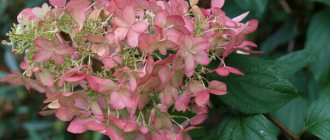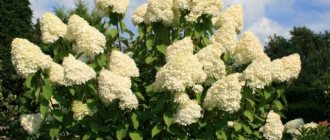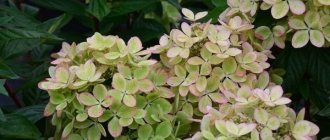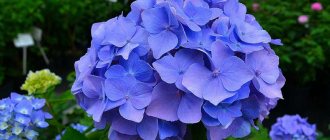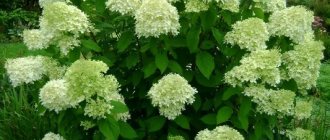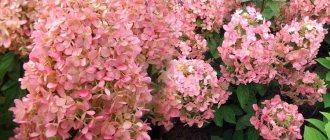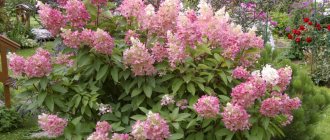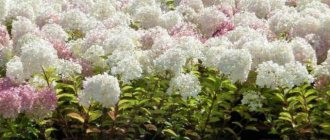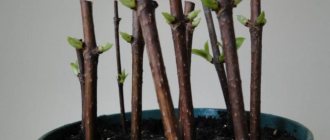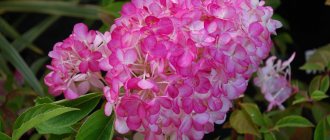Large-leaved hydrangeas Endless Summer
Large-leaved hydrangea from the Forever&Ever series - Red Sensation Over several years of my stay on the site, I came across questions in which people often asked why their hydrangea does not bloom or how they can change its color. It can be difficult to give the correct answer, and even in a nutshell, if you don’t know what kind of hydrangea we are talking about. Often a person buys a plant without knowing the variety, without knowing its genetic predisposition and not always understanding how it will grow in his specific conditions and on his specific soils. I myself have been dealing with these issues for a long time and now I have decided to share some of my knowledge and my modest experience with you. There are five main types of hydrangeas that are grown in gardens: paniculate, tree, petiolate, groundcover and large-leaved. Large-leaved hydrangea (lat. Hydrángea macrophýlla) is also called “broad-leaved”, “garden” and “macrophila”. This post will talk about large-leaved hydrangeas - macrophiles that bloom on the shoots of the current year, which grow in our garden near Moscow.
Large-leaved hydrangeas Endless Summer I’ll tell you about my experience in growing these wonderful flowers. I will tell you about the successes and failures that I had to face, and thanks to which I gained my personal experience. You can successfully grow macrophiles if you understand the nature of these plants. In regions with warm winters, there are no problems with growing and flowering large-leaved hydrangea, but our winters make their own adjustments to the conditions for growing these wonderful flowers. My first unsuccessful attempts to grow these beautiful flowers in the garden were made about 20 years ago. These were large-leaved hydrangeas that bloomed on last year’s shoots and which, despite all my tricks in covering the plants for the winter, refused to bloom in the summer. The problem was preserving flower buds in winter. In these macrophiles, a flower bud laid this year blooms only the next (second) year, which is why it is difficult to preserve it in winter. The crowns, where the flower buds are located, are the most immature part of the plants, and in winter they most often froze and had to be cut off along with the dead flower buds. However, global selection does not stand still, and in recent years large-leaved hydrangeas have appeared on the market, blooming on the shoots of the current year. With the advent of these varieties, most macrophile lovers have a real opportunity to see their lush flowering in their garden.
Large-leaved hydrangeas Endless Summer In these macrophiles, the flower bud, laid in the spring on a young shoot, blooms in the same year in the second half of summer. This aroused great interest in them, since there was no longer a need to preserve entire shoots in the winter at all costs. Even if in winter it is not possible to preserve the entire shoot and in the spring it is necessary to remove the dead part of the plants, then after such pruning from the axils of the remaining lower part of the old shoot, young shoots of the second order begin to grow with flower buds that will bloom in the same year. In addition, these new varieties of macrophiles, flowering on the shoots of the current year, as a rule, have increased winter hardiness (up to -30ºC). These varieties include macrophiles from the Endless Summer, Forever&Ever and You&Me series. However, frost resistance to -30ºC refers to the frost resistance of the root system, but not to the flower buds. They also freeze, like all other macrophiles. But in the above-mentioned varieties, the rate of flower bud ripening is much higher than in other varieties. A bud formed in the spring on the shoot of the current year manages to ripen and bloom by the end of the same season. That's the trick. At the dawn of my interest in macrophiles, I accidentally came across a book about growing hydrangeas by the American author, Dr. Michael Dirr from the University of Georgia, which greatly helped me understand these plants and find a common language with them. The author of the book is called the “Hydrangea Guru” - the Guru in the field of hydrangeas. It’s a pity that we don’t sell these books in translation yet; there is a lot of interesting and useful information on growing hydrangeas. In our garden we grow the varieties Endless Summer and the Red Sensation variety from the Forever&Ever series, so we will talk about them.
Ads by
Hydrangea macrophylla: description and origin
Hydrangea Macrophylla belongs to the genus Hydrangea, family Hydrangeaceae. China and the Japanese Islands are considered the birthplace of hydrangea, and Hydrangea Macrophylla seedlings were brought to European territory almost two hundred years ago. Since then, breeders have developed more than a hundred more hybrids. Most of the new varieties were bred in France, for example, one of the most beautiful and original - Miss Saori hydrangea with flowers resembling a prickly ball of very original colors.
Garden hydrangea - decorating areas
The height of the Macrophylla hydrangea bush can reach one and a half meters (limited by cold climatic conditions). The leaves are large, bright green and egg-shaped. Widely spreading shoots extend straight from the trunk.
Lush inflorescences are collected in balls of 20 cm in diameter. The color palette varies from lilac to blue and even pink.
Ball-shaped inflorescences of Hydrangea Macrophylla
Note! Small, lilac-blue flowers are usually fruitful, while large and pink flowers with bright spots, on the contrary, are sterile. In this case, fruiting plates (fertile) grow in the center of the flower, and sterile (sterile) ones grow along the edges.
Difficult choice among many varieties
Choosing large-leaved hydrangea is not at all easy. Not only many varieties of hydrangea macrophila have been bred for open ground, but also for growing in pots. Problems with winter hardiness and acclimatization sometimes arise with imported varieties. For a good wintering, even with shelter, varieties adapted to our climate are suitable. The frost resistance of the plant declared by the seller is very important. Hydrangeas brought from Europe can be capricious. We invite you to get acquainted with the most suitable macrophiles for the climate of the middle zone.
Let's start with a charming double variety of hydrangea that changes its color from bright pink to reddish-green - "papillon". The bush of this plant is very compact, the leaves are dark green. Hydrangea has dense large inflorescences. The double flowers themselves look like small roses.
The remontant hydrangea “blueberry cheesecake” grows as a compact meter-long bush. It is much larger in width than in height. This purple beauty blooms in July, but the inflorescences last until November. The leaves are dark green in summer and begin to turn red in autumn.
A spreading variety of hydrangia, reaching a height of up to one and a half meters, is the “four colors” variety. It has very large inflorescences and rich green leaves with original spots. The flower has this name because the inflorescences on one bush can be of four shades: white, pink, lilac, blue.
A very beautiful ruffled remontant variety with a dark pink tint and purple tints is the “spike” variety. Its flowers have a corrugated wavy edge of the petals. Being inflorescences in the form of a very large sphere, the flowers of this variety fit so tightly to each other that they cannot fully bloom. The leaves of the “spike” are very bright, and the flowers are white-blue-green.
Another hybrid variety of hydrangea is considered to be “green shadow”. It is distinguished by a wavy and jagged edge of bright pink petals with a yellow-light green center. This variety grows as a compact, dense bush one meter high. The inflorescences are distinguished by the fact that they have openwork blooms. The bushes have a solemn and noble appearance.
A one and a half meter tall bright variety with inflorescences in the form of spherical caps - “Gerda Steiniger”. Its inflorescences have a rich raspberry-lilac color. By the end of summer, the color of the flowers changes. The bush has an ideal shape thanks to its straight shoots. If this hydrangea freezes a little in the winter, it quickly recovers in the spring.
Erect, rigid shoots and stunningly beautiful variegated foliage are observed in the “tricolor” variety. The flowers of this plant are white with yellow and pink spots. The leaves have a muted green color. It is important to note that the Tricolor variety does not tolerate alkaline soil.
Many gardeners admire the legendary remontant variety, which is considered the standard for growing in the middle zone - “endless summer”. The flowers can be either soft pink or blue. The inflorescence balls can reach a diameter of up to 20 cm. The straight stems of this plant are quite well adapted to harsh winters.
The legendary variety, distinguished by the most delicate, watercolor, pastel-fawn color of the inflorescences, is the “shiny bride”. The light white flowers of this variety have a semi-double shape, as well as pink, blue, and lilac colors with spots in the center. This is an early flowering plant that is disease resistant.
In addition to the above varieties, you need to add other frost-resistant varieties: “Hamburg”, “Lanart White”, “Admiration”, “Early Sensation”, “All Summer”. This is a rather incomplete list of garden hydrangeas. We also need to remember the following varieties: “mini-penny”, “bouquet of roses”, “love”, “passion”, “forever”, “romance”.
How Hydrangea Macrophylla blooms
Hydrangea Paniculata Strawberry Blossom - description
Hydrangea Macrophila blooms in early summer. Flowering (depending on the variety) continues until mid-autumn. In buds, the petals are painted white with a light light green tint. As they bloom, they become blue, pink, lilac, purple or simply snow-white.
The color palette of inflorescences is greatly influenced by the acidity of the soil:
- neutral acidity gives a white or creamy tint;
- alkaline soil makes the flowers lilac or pinkish;
- Acidic soil promotes the appearance of blue and purple “balls”.
Disease and pest control
Alkaline soil promotes the development of chlorosis in hydrangeas. This affects the color of the leaves of the plant: they become lighter or turn yellow. To prevent this disease, you need to use only soft water and fertilize with iron salts. If the foliage nevertheless turns yellow, then use a solution of potassium nitride and ferrous sulfate.
Hot, dry weather contributes to spider mite infestations. It causes the leaves to dry out and fall off. In such cases, the bushes need to be sprayed with Actellik. Eliminate downy mildew in the form of oily spots on the leaves with fungicides. If rust appears, treat the plant with copper sulfate.
If you properly care for your macrophila, this beauty will delight you with abundant flowering for a long time. Be sure to have a magnificent large-leaved hydrangea in your garden.
Growing hydrangea in open ground
According to the description of Macrophila hydrangea, the key to its lush and long flowering is the correct determination of the planting site and strict adherence to agrotechnical rules. Manipulations should be carried out very carefully and accurately. It is important to adhere to the appropriate timing for planting a flower in open ground (especially for central Russia with its harsh winters). This should be done in the spring, as soon as the soil has completely thawed and warmed up sufficiently in the spring sun. At this time, return frosts no longer occur. Bushes are planted keeping a distance of one meter between them.
What is needed for planting
Hydrangea Bombshell paniculata - description
In order for the cultivation of hydrangea to be successful, the optimal soil should be prepared for it. It should have the following composition:
- humus;
- turf land;
- rotted leaves;
- peat mixture or sawdust from coniferous trees;
- fine sand;
- special feed additives for hydrangeas (can be purchased at garden stores).
The components of the soil are taken in equal parts.
Choosing the optimal location
Despite the fact that hydrangeas are considered shade-tolerant plants, this does not apply to this variety. Even in southern latitudes, Macrophyll bushes grow in maximum partial shade, and in the harsh Russian climate they are considered sun lovers. However, it is also not worth planting it in too open flower beds.
Note! Large-leaved hydrangea is best suited to an area illuminated by the sun in the morning and evening hours. In the very sun, the spherical inflorescences will wither.
It is also necessary to take into account the proximity of other bushes and trees (buildings). Hydrangea Macrophylla is a moisture-loving plant, so it may not have enough water in the soil due to such large neighbors.
Step by step planting process
For the Hydrangea rough Macrophylla shrub, planting and care are carried out according to the following algorithm:
- The purchased flower is taken out of the pot and soaked in a container of water for 2-3 hours. The roots need to be divided, but it is better not to remove the soil from them for better adaptation of the bush to the new place.
- Dig a hole in the chosen place and 24 hours before planting the bush, fill it with water at the rate of two buckets of water per hole.
- The holes are filled with soil mixture with the addition of potassium-phosphorus fertilizers.
- The young plant is placed in the hole. The roots of the flower should be carefully straightened for better rooting.
- The root zone is sprinkled with earth and lightly compacted.
- A freshly planted bush is watered abundantly, the soil around it is mulched with straw or dry peat.
Planting hydrangeas in open ground
Correct landing
Plant macrophila hydrangeas in the spring, when the soil has warmed up and frosts have completely stopped. If you plan to plant several bushes, then place them at a distance of at least a meter from each other. For small seedlings, dig a 30 cm hole. For a large plant, you need to dig deeper. Don't forget to make drainage from pebbles.
Buy a special earthen mixture or make it yourself according to the above scheme. Apply some organic and mineral fertilizers. With them, flower buds will form better for next year. Lower the bush into the hole, cover it with soil, water it, and then mulch it with pine needles, sawdust or hay. This will retain moisture under the bush. In summer, lightly loosen the mulch.
Propagation of Hydrangea Macrophylla
Hydrangea Tardiva - description of the variety
This type of hydrangea is propagated by cuttings, layering and dividing the bush.
Propagation by cuttings
Cuttings are taken in early spring from a perennial bush. The cut stem should have one internode. The upper cut is made at a right angle, and the lower one at a sharp angle, and half of each leaf is also cut off. Next, the cutting is half buried in moist soil and covered with plastic film, which is removed after rooting.
Hydrangea cuttings
Reproduction by layering
To obtain layering, one-year-old hydrangea shoots are tilted to the ground and covered with earth, leaving only the top 20-25 cm long on the soil surface. The cuttings should be watered once every three days, and after rooting they are cut off from the parent bush and planted in separate holes.
Dividing the bush
An overgrown bush of large-leaved hydrangea can be divided. To do this, the rhizome should be freed from the clod of earth and the old stems should be cut off. The bush is divided into several parts. Their roots should be trimmed and the cuttings immediately planted in their designated places. Then water the soil generously.
Caring for Hydrangea Macrophylla
Care for the Hydrangea Macrophylla flower at home and in the open ground consists of proper watering, feeding, protection from diseases and frost.
Watering mode
Hydrangea Macrophylla loves moisture, it’s not for nothing that the plant is also called hydrangea. Therefore, watering should be carried out at least once every couple of days, the minimum volume of water is 1-2 buckets per bush. Water that is settled and purified, soft or acidified (for blue and lilac species) is suitable. In hot weather you need more water.
Note! The plant's roots and root zone should always be moist, otherwise lush color may not be expected. Moisture in the soil is retained by mulching with pine needles or pine bark.
Watering hydrangea
Top dressing
Hydrangea needs intensive feeding with organic matter (liquefied manure, chicken droppings) and balanced mineral complexes. There are fertilizers on sale specifically for this type of plant (mainly phosphorus). The frequency of feeding the flower is a couple of times a month.
Features of care during the flowering period
For Hydrangea Macrophylla, when caring at home, it is important to take into account the desired color of the flowers. Which specific component to choose fertilizer with depends on the desired color of the hydrangea “balls”. For example, special fertilizers containing aluminum give a pink color.
During the period of throwing out buds, it is necessary to supply the plant with a large amount of microelements. You should also cut off the basal side shoots, leaving the strongest ones.
Fertilizer for large-leaved hydrangea
Features of care during the rest period
After flowering, you need to cut off all the dried parts of the bush and thin out its center. Last year's stems are left for future flowering.
Preparing for winter
This type of hydrangea has average winter hardiness. To prevent the flower from being damaged by frost, it must be cleared of dry leaves, the branches tied into bunches, tilted and pressed to the ground. Wrap these “piles” with non-woven fabric and cover them with leaves.
Note! Small tender bushes can be dug up, planted in pots and sent indoors for the winter.
The unique spherical flowers of large-leaved bush hydrangea have many fans among gardeners. Caring for the plant is quite difficult, but beautiful lush flowering will be a worthy reward for your efforts.
Setting the stage
Slightly or moderately acidic soil is suitable for planting garden hydrangea. Add turf and leaf soil, a little sand, peat, and humus to the soil. Take everything in equal parts. Hydrangia does not tolerate lime - remember this. It blooms with pink flowers on slightly acidic soils, and blue and blue flowers on acidic soils.
It will be better if before planting hydrangea you go to the forest to get soil. Dig up the soil under the pine trees, also grab pine needles and cones. This is exactly the kind of soil that the pink macrophila loves.

